The Economics and Statistics Division maintains archives of previous publications for accountability purposes, but makes no updates to keep these documents current with the latest data revisions from Statistics Canada. As a result, information in older documents may not be accurate. Please exercise caution when referring to older documents. For the latest information and historical data, please contact the individual listed to the right.
<--- Return to Archive
For additional information relating to this article, please contact:
February 17, 2021ANALYSIS OF NOVA SCOTIA'S CONSUMER PRICE INDEX FOR JANUARY 2021 TRENDS – JANUARY 2021
Nova Scotia’s All-Items Consumer Price Index (CPI) increased 1.3% year-over-year in January 2021. Nationally, consumer prices were up 1.0% from a year earlier. Compared to December 2020, monthly consumer prices increased 1.2% in Nova Scotia and 0.6% in Canada.
On a year-over-year basis, national CPI growth increased from 0.7% in December 2020 to 1.0% in January 2021. The increase in CPI growth was mostly due to higher prices for durable goods (+1.7%) and gasoline prices (+6.1%).
Statistics Canada noted that the overall consumer price increase seen in January was due to steadily increasing commodity prices since April 2020. While the vaccine roll-out plans support an increase in consumer spending expectations, second round containment measures imposed in some provinces weighed on consumer spending.
Gasoline prices increased 6.1% month-over-month in January, posting the second consecutive monthly gain. Production setbacks by major oil-producing countries supported higher gasoline prices. However, gasoline prices were still 3.3% lower compared to January 2020.
Impact of COVID-19 on the Consumer Price Index
Statistics Canada continued special CPI program measures for January 2021. Due to COVID-19 impact on product availability, select sub-components of the CPI received temporary special imputations. The sub-indexes for travel tours, components of spectator entertainment, recreational services, personal care services in some areas, and some components of use of recreational facilities and services in some areas were imputed from the monthly change in the all-items index - effectively removing the impact of these goods and services on the CPI. The price indexes for beer, wine and liquor served in licensed establishments were imputed in several regions, using the indexes to which consumers likely redirected their expenditures: beer, wine and liquor purchased from stores.
Prices increased year-over-year in all provinces led by Newfoundland and Labrador (+1.5%). Prince Edward Island (+0.5%) posted the lowest gain in percentage terms across all provinces in January 2021.

The main contributors to the monthly change (January 2021 vs. December 2020) in Nova Scotia CPI were:
- Gasoline (+11.4%)
- Purchase and leasing of passenger vehicles (+2.8%)
- Fuel oil and other fuels (+5.8%)
- Inter-city transportation (-4.6%)
- Rent (-0.6%)
- Footwear (-3.8%)
Nova Scotia's consumer price inflation (year-over-year growth in CPI) excluding food and energy was 2.0% in January. All provinces reported year-over-year increases with the national rate at 1.4%. Newfoundland and Labrador (+2.1%), Nova Scotia (+2.0%) and Quebec (+1.7%) reported the largest price level increases, while Manitoba (+0.5%) reported the smallest increase. Compared to the previous month, the CPI excluding food and energy was up in all provinces.
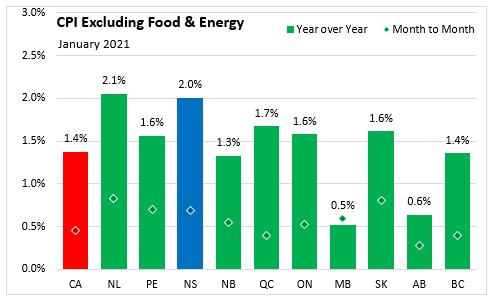
The CPI for food in Nova Scotia increased 1.2% year-over-year in January. Year-over-year, food prices increased in all provinces with the national average at 1.0%. The largest annual gain was recorded in Prince Edward Island (+2.1%) and New Brunswick (+1.7%), while Saskatchewan (+0.3%) posted the smallest increase. Food prices increased 0.9% month-over-month in Canada and 0.8% in Nova Scotia.
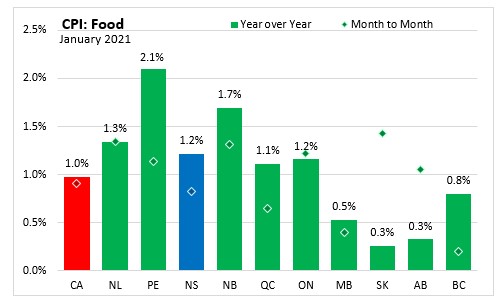
In January, the Nova Scotia energy price index decreased 4.6% compared to a year ago. Year-over-year energy price indexes decreased in every province except Alberta and Manitoba, with a national average decline of -2.7%. The largest annual decline was in Prince Edward Island (-8.9%).
Monthly energy prices (Jan 2021 vs Dec 2020) were up in eight of ten provinces, with the largest decline in Ontario (-1.8%). Energy prices increased in Nova Scotia by 6.3% compared to December 2020, posting the largest monthly increase across all provinces. Nationally, energy prices were up 1.5% from the previous month.
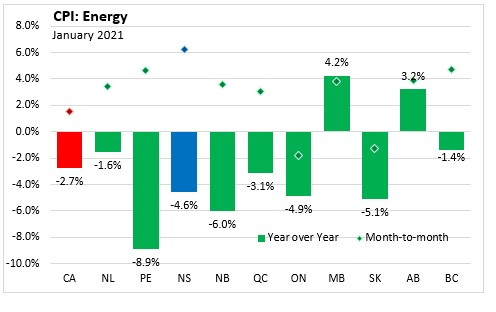
Year-over-year, shelter prices in Nova Scotia increased 0.3% in January 2021, lower than the national average increase of 1.4%. Compared to the previous year, shelter prices were down in Prince Edward Island (-1.6%), Saskatchewan (-0.5%) and New Brunswick (-0.1%).
Monthly shelter prices were also up 0.3% in Nova Scotia while nationally shelter prices declined 0.2% in January.

Nova Scotia's consumer price inflation (year-over-year growth in CPI) excluding energy was 1.9% in January compared to a national rate of 1.3%. Nova Scotia and Newfoundland and Labrador both at +1.9% posted the largest year-over-year gain while Manitoba and Alberta registered the lowest annual gain both at 0.6%.
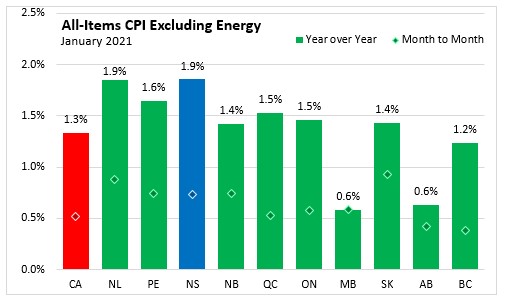
Major Components for January 2021
The following table shows the price increases specific to Nova Scotia for the major components of the CPI this month:
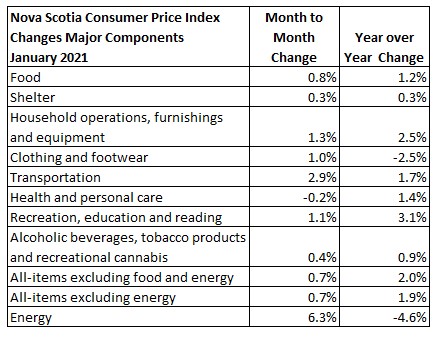
Long Run Trends
In January 2021, the All-Items CPI year-over-year inflation rate for Nova Scotia was 1.3%, above Canada's average at 1.0%. Nova Scotia's annual inflation has mostly been below the Canadian average since mid-2014, with the exception of only a few months. While month-to-month movements in the indices can be different, over time they generally follow the same overall trend.

Annual inflation for the CPI excluding food and energy in Nova Scotia (+2.0%) was higher than the national rate (+1.4%) in January 2021.

Bank of Canada's preferred measures of core inflation
Compared to January 2020, CPI-Common increased 1.3%, CPI-Median rose 1.4% and CPI-Trim was up 1.8% in Canada. All-items CPI excluding eight of the most volatile components as defined by the Bank of Canada and excluding the effect of changes in indirect taxes (formerly referred to as CPIX), rose 1.6% year-over-year.
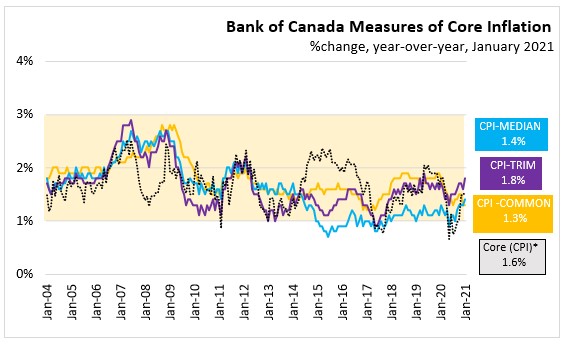
Appendix Tables and Charts
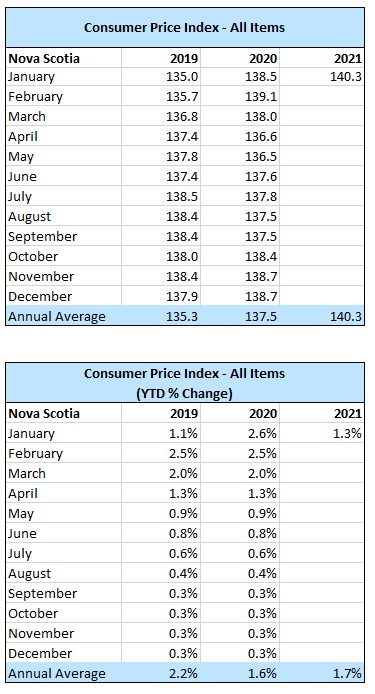
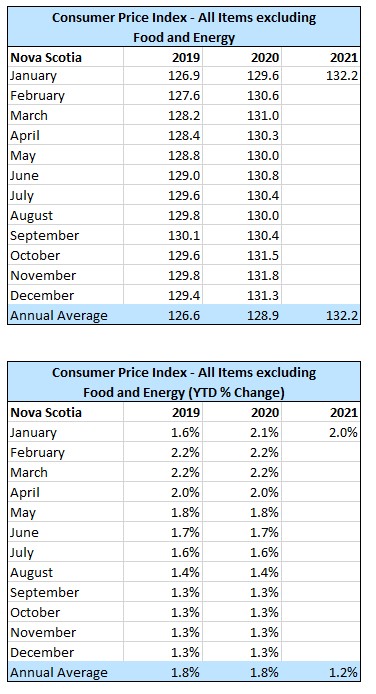
Source: Statistics Canada data portal: Tables 18-10-0004-01 and 18-10-0256-01
<--- Return to Archive